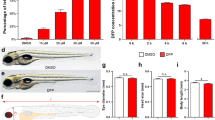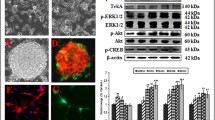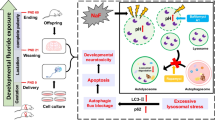Abstract
The persistent xenobiotic agent 2,3,7,8-tetrachlorodibenzo-p-dioxin (TCDD) induces neurotoxic effects that alters neurodevelopment and behavior both during development and adulthood. There are many ongoing efforts to determine the molecular mechanisms of TCDD-mediated neurotoxicity, the signaling pathways involved and its molecular targets in neurons. In this work, we have used SHSY5Y human neuroblastoma cells to characterize the TCDD-induced toxicity. TCDD produces a loss of viability linked to an increased caspase-3 activity, PARP-1 fragmentation, DNA laddering, nuclear fragmentation and hypodiploid (apoptotic) DNA content, in a similar way than staurosporine, a prototypical molecule of apoptosis induction. In addition, TCDD produces a decrease of mitochondrial membrane potential and an increase of intracellular calcium concentration (P < 0.05). Finally, based on the high lipophilic properties of the dioxin, we test the TCDD effect on the membrane integrity using sarcoplasmic reticulum vesicles as a model. TCDD produces calcium efflux through the membrane and an anisotropy decrease (P < 0.05) that reflects an increase in membrane fluidity. Altogether these results support the hypothesis that TCDD toxicity in SHSY5Y neuroblastoma cells provokes the disruption of calcium homeostasis, probably affecting membrane structural integrity, leading to an apoptotic process.








Similar content being viewed by others
References
Ahmed RG (2011) Perinatal TCDD exposure alters developmental neuroendocrine system. Food Chem Toxicol 49:1276–1284
Mates JM, Segura JA, Alonso FJ, Marquez J (2010) Roles of dioxins and heavy metals in cancer and neurological diseases using ROS-mediated mechanisms. Free Rad Biol Med 49:1328–1341
Shibamoto T, Yasuhara A, Katami T (2007) Dioxin formation from waste incineration. Rev Environ Contam Toxicol 190:1–41
Bock KW, Kohle C (2006) Ah receptor: dioxin-mediated toxic responses as hints to deregulated physiologic functions. Biochem Pharmacol 72:393–404
Mimura J, Fujii-Kuriyama Y (2003) Functional role of AhR in the expression of toxic effects by TCDD. Biochim Biophys Acta 1619:263–268
Schantz SL, Ferguson SA, Bowman RE (1992) Effects of 2,3,7,8-tetrachlorodibenzo-p-dioxin on behavior of monkeys in peer groups. Neurotoxicol Teratol 14:433–446
Schantz SL, Bowman RE (1989) Learning in monkeys exposed perinatally to 2,3,7,8-tetrachlorodibenzo-p-dioxin (TCDD). Neurotoxicol Teratol 11:13–19
Rogan WJ, Gladen BC (1992) Neurotoxicology of PCBs and related compounds. Neurotoxicology 13:27–35
Jacobson JL, Jacobson SW (1996) Intellectual impairment in children exposed to polychlorinated biphenyls in utero. N Engl J Med 335:783–789
Jacobson JL, Jacobson SW (1997) Evidence for PCBs as neurodevelopmental toxicants in humans. Neurotoxicology 18:415–424
Jacobson JL, Jacobson SW (1997) Teratogen update: polychlorinated biphenyls. Teratology 55:338–347
Legare ME, Hanneman WH, Barhoumi R, Burghardt RC, Tiffany-Castiglioni E (2000) 2,3,7,8-Tetrachlorodibenzo-p-dioxin alters hippocampal astroglia-neuronal gap junctional communication. Neurotoxicology 21:1109–1116
Nayyar T, Zawia NH, Hood DB (2002) Transplacental effects of 2,3,7,8-tetrachlorodibenzo-p-dioxin on the temporal modulation of Sp1 DNA binding in the developing cerebral cortex and cerebellum. Exp Toxicol Pathol 53:461–468
Collins LL, Williamson MA, Thompson BD, Dever DP, Gasiewicz TA, Opanashuk LA (2008) 2,3,7,8-Tetracholorodibenzo-p-dioxin exposure disrupts granule neuron precursor maturation in the developing mouse cerebellum. Toxicol Sci 103:125–136
Boas M, Feldt-Rasmussen U, Main KM (2012) Thyroid effects of endocrine disrupting chemicals. Mol Cell Endocrinol 355:240–248
Kim SY, Yang JH (2005) Neurotoxic effects of 2,3,7,8-tetrachlorodibenzo-p-dioxin in cerebellar granule cells. Exp Mol Med 37:58–64
Lin CH, Chen CC, Chou CM, Wang CY, Hung CC, Chen JY, Chang HW, Chen YC, Yeh GC, Lee YH (2009) Knockdown of the aryl hydrocarbon receptor attenuates excitotoxicity and enhances NMDA-induced BDNF expression in cortical neurons. J Neurochem 111:777–789
Lin CH, Juan SH, Wang CY, Sun YY, Chou CM, Chang SF, Hu SY, Lee WS, Lee YH (2008) Neuronal activity enhances aryl hydrocarbon receptor-mediated gene expression and dioxin neurotoxicity in cortical neurons. J Neurochem 104:1415–1429
Marinkovic N, Pasalic D, Ferencak G, Grskovic B, Stavljenic Rukavina A (2010) Dioxins and human toxicity. Arh Hig Rada Toksikol 61:445–453
Hu W, Jones PD, DeCoen W, King L, Fraker P, Newsted J, Giesy JP (2003) Alterations in cell membrane properties caused by perfluorinated compounds. Comp Biochem Physiol C 135:77–88
Hortigon-Vinagre MP, Chardonnet S, Montigny C, Gutierrez-Martin Y, Champeil P, Henao F (2011) Inhibition by 4-hydroxynonenal (HNE) of Ca2+ transport by SERCA1a: low concentrations of HNE open protein-mediated leaks in the membrane. Free Rad Biol Med 50:323–336
Zundorf G, Reiser G (2011) Calcium dysregulation and homeostasis of neural calcium in the molecular mechanisms of neurodegenerative diseases provide multiple targets for neuroprotection. Antioxid Redox Signal 14:1275–1288
Biedler JL, Helson L, Spengler BA (1973) Morphology and growth, tumorigenicity, and cytogenetics of human neuroblastoma cells in continuous culture. Cancer Res 33:2643–2652
Busciglio J, Yankner BA (1995) Apoptosis and increased generation of reactive oxygen species in Down’s syndrome neurons in vitro. Nature 378:776–779
Sanfeliu C, Cristofol R, Toran N, Rodriguez-Farre E, Kim SU (1999) Use of human central nervous system cell cultures in neurotoxicity testing. Toxicol In Vitro 13:753–759
Chopra M, Schrenk D (2011) Dioxin toxicity, aryl hydrocarbon receptor signaling, and apoptosis-persistent pollutants affect programmed cell death. Crit Rev Toxicol 41:292–320
Sanchez-Martin FJ, Fernandez-Salguero PM, Merino JM (2010) 2,3,7,8-Tetrachlorodibenzo-p-dioxin induces apoptosis in neural growth factor (NGF)-differentiated pheochromocytoma PC12 cells. Neurotoxicol 31:267–276
Sanchez-Martin FJ, Fernandez-Salguero PM, Merino JM (2011) Aryl hydrocarbon receptor-dependent induction of apoptosis by 2,3,7,8-tetrachlorodibenzo-p-dioxin in cerebellar granule cells from mouse. J Neurochem 118:153–162
Mulero-Navarro S, Santiago-Josefat B, Pozo-Guisado E, Merino JM, Fernandez-Salguero PM (2003) Down-regulation of CYP1A2 induction during the maturation of mouse cerebellar granule cells in culture: role of nitric oxide accumulation. Eur J Neurosci 18:2265–2272
Valera E, Sanchez-Martin FJ, Ferrer-Montiel AV, Messeguer A, Merino JM (2008) NMDA-induced neuroprotection in hippocampal neurons is mediated through the protein kinase A and CREB (cAMP-response element-binding protein) pathway. Neurochem Int 53:148–154
Sanchez-Martin FJ, Valera E, Casimiro I, Merino JM (2010) Nerve growth factor increases the sensitivity to zinc toxicity and induces cell cycle arrest in PC12 cells. Brain Res Bull 81:458–466
Martin-Romero FJ, Garcia-Martin E, Gutierrez-Merino C (2002) Inhibition of oxidative stress produced by plasma membrane NADH oxidase delays low-potassium-induced apoptosis of cerebellar granule cells. J Neurochem 82:705–715
Grynkiewicz G, Poenie M, Tsien RY (1985) A new generation of Ca2+ indicators with greatly improved fluorescence properties. J Biol Chem 260:3440–3450
MacLennan DH (1970) Purification and properties of an adenosine triphosphatase from sarcoplasmic reticulum. J Biol Chem 245:4508–4518
De Foresta B, Henao F, Champeil P (1992) Kinetic characterization of the perturbation by dodecylmaltoside of sarcoplasmic reticulum Ca2+-ATPase. Eur J Biochem 209:1023–1034
Weil M, Jacobson MD, Coles HS, Davies TJ, Gardner RL, Raff KD, Raff MC (1996) Constitutive expression of the machinery for programmed cell death. J Cell Biol 133:1053–1059
Kaufmann SH, Desnoyers S, Ottaviano Y, Davidson NE, Poirier GG (1993) Specific proteolytic cleavage of poly(ADP-ribose) polymerase: an early marker of chemotherapy-induced apoptosis. Cancer Res 53:3976–3985
Orrenius S, Zhivotovsky B, Nicotera P (2003) Regulation of cell death: the calcium-apoptosis link. Nat Rev Mol Cell Biol 4:552–565
Kroemer G, Galluzzi L, Brenner C (2007) Mitochondrial membrane permeabilization in cell death. Physiol Rev 87:99–163
Pohjanvirta R, Vartiainen T, Uusi-Rauva A, Monkkonen J, Tuomisto J (1990) Tissue distribution, metabolism, and excretion of 14C-TCDD in a TCDD-susceptible and a TCDD-resistant rat strain. Pharmacol Toxicol 66:93–100
Bell DR, Clode S, Fan MQ, Fernandes A, Foster PM, Jiang T, Loizou G, MacNicoll A, Miller BG, Rose M, Tran L, White S (2007) Toxicity of 2,3,7,8-tetrachlorodibenzo-p-dioxin in the developing male Wistar (Han) rat. I: no decrease in epididymal sperm count after a single acute dose. Toxicol Sci 99:214–223
Bell DR, Clode S, Fan MQ, Fernandes A, Foster PM, Jiang T, Loizou G, MacNicoll A, Miller BG, Rose M, Tran L, White S (2007) Toxicity of 2,3,7,8-tetrachlorodibenzo-p-dioxin in the developing male Wistar(Han) rat. II: chronic dosing causes developmental delay. Toxicol Sci 99:224–233
Fernandez M, Paradisi M, D’Intino G, Del Vecchio G, Sivilia S, Giardino L, Calza L (2010) A single prenatal exposure to the endocrine disruptor 2,3,7,8-tetrachlorodibenzo-p-dioxin alters developmental myelination and remyelination potential in the rat brain. J Neurochem 115:897–909
Williamson MA, Gasiewicz TA, Opanashuk LA (2005) Aryl hydrocarbon receptor expression and activity in cerebellar granule neuroblasts: implications for development and dioxin neurotoxicity. Toxicol Sci 83:340–348
Lee HG, Kim SY, Choi EJ, Park KY, Yang JH (2007) Translocation of PKC-βII is mediated via RACK-1 in the neuronal cells following dioxin exposure. Neurotoxicol 28:408–414
Schwarz M, Buchmann A, Stinchcombe S, Kalkuhl A, Bock K (2000) Ah receptor ligands and tumor promotion: survival of neoplastic cells. Toxicol Lett 112–3:69–77
McConkey DJ, Hartzell P, Duddy SK, Hakansson H, Orrenius S (1988) 2,3,7,8-Tetrachlorodibenzo-p-dioxin kills immature thymocytes by Ca2+-mediated endonuclease activation. Science 242:256–259
Kurl RN, Abraham M, Olnes MJ (1993) Early effects of 2,3,7,8-tetrachlorodibenzo-p-dioxin (TCDD) on rat thymocytes in vitro. Toxicology 77:103–114
Tombal B, Denmeade SR, Isaacs JT (1999) Assessment and validation of a microinjection method for kinetic analysis of [Ca2+]i in individual cells undergoing apoptosis. Cell Calcium 25:19–28
Lynch K, Fernandez G, Pappalardo A, Peluso JJ (2000) Basic fibroblast growth factor inhibits apoptosis of spontaneously immortalized granulosa cells by regulating intracellular free calcium levels through a protein kinase Cdelta-dependent pathway. Endocrinology 141:4209–4217
Dow GS, Hudson TH, Vahey M, Koenig ML (2003) The acute neurotoxicity of mefloquine may be mediated through a disruption of calcium homeostasis and ER function in vitro. Malar J 2:14
Pinton P, Rizzuto R (2006) Bcl-2 and Ca2+ homeostasis in the endoplasmic reticulum. Cell Death Differ 13:1409–1418
Korge P, Weiss JN (1999) Thapsigargin directly induces the mitochondrial permeability transition. Eur J Biochem 265:273–280
Akao Y, Maruyama W, Shimizu S, Yi H, Nakagawa Y, Shamoto-Nagai M, Youdim MB, Tsujimoto Y, Naoi M (2002) Mitochondrial permeability transition mediates apoptosis induced by N-methyl(R)salsolinol, an endogenous neurotoxin, and is inhibited by Bcl-2 and rasagiline, N-propargyl-1(R)-aminoindan. J Neurochem 82:913–923
Shertzer HG, Genter MB, Shen D, Nebert DW, Chen Y, Dalton TP (2006) TCDD decreases ATP levels and increases reactive oxygen production through changes in mitochondrial F(0)F(1)-ATP synthase and ubiquinone. Toxicol Appl Pharmacol 217:363–374
Tappenden DM, Lynn SG, Crawford RB, Lee K, Vengellur A, Kaminski NE, Thomas RS, LaPres JJ (2011) The aryl hydrocarbon receptor interacts with ATP5α1, a subunit of the ATP synthase complex, and modulates mitochondrial function. Toxicol Appl Pharmacol 254:299–310
Paajarvi G, Viluksela M, Pohjanvirta R, Stenius U, Hogberg J (2005) TCDD activates Mdm2 and attenuates the p53 response to DNA damaging agents. Carcinogenesis 26:201–208
Aly HA, Domenech O (2009) Cytotoxicity and mitochondrial dysfunction of 2,3,7,8-tetrachlorodibenzo-p-dioxin (TCDD) in isolated rat hepatocytes. Toxicol Lett 191:79–87
Alsharif NZ, Grandjean CJ, Murray WJ, Stohs SJ (1990) 2,3,7,8-Tetrachlorodibenzo-p-dioxin (TCDD)-induced decrease in the fluidity of rat liver membranes. Xenobiotica 20:979–988
Acknowledgments
This study was supported by a Grant from the Junta de Extremadura, Spain (PRI07A019 to JM Merino), Junta de Extremadura (GRU10008) and from the Red Temática de Investigación Cooperativa en Cáncer (RTICC) (RD 06/020/1016, Fondo de Investigaciones Sanitarias (FIS), Carlos III Institute, Spanish Ministry of Health). AM-H, FJS-M and MPH-V are the recipients of predoctoral fellowships from the Junta de Extremadura (Spain). All Spanish funding is co-sponsored by the European Union FEDER program.
Conflict of interests
None.
Author information
Authors and Affiliations
Corresponding author
Electronic supplementary material
Below is the link to the electronic supplementary material.
Rights and permissions
About this article
Cite this article
Morales-Hernández, A., Sánchez-Martín, F.J., Hortigón-Vinagre, M.P. et al. 2,3,7,8-Tetrachlorodibenzo-p-dioxin induces apoptosis by disruption of intracellular calcium homeostasis in human neuronal cell line SHSY5Y. Apoptosis 17, 1170–1181 (2012). https://doi.org/10.1007/s10495-012-0760-z
Published:
Issue Date:
DOI: https://doi.org/10.1007/s10495-012-0760-z




